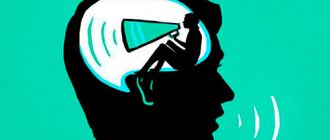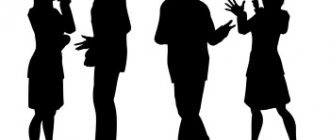Updated July 23, 2021 318 Author: Dmitry Petrov
Hello, dear readers of the KtoNaNovenkogo.ru blog. Each of us has a general idea of what speech is. However, there are significant differences in the understanding of this word by different people.
Even in dictionary interpretations, this phenomenon is referred to either as the activity of the speaker, or as a form of communication, or in general as a person’s psychological ability to express thoughts.
Today we’ll talk about how linguists understand speech, what types and functions they distinguish. Finally, let's figure out what the border is between language and speech.
Speech is...
In the scientific world there is rarely a unified meaning for such voluminous concepts as speech. However, the interpretation of Nina Davidovna Arutyunova, one of the most famous linguists of our time, is recognized by the majority of linguists. It sounds like this:
Speech is specific speaking that occurs in audio (including internal pronunciation) or written form.
In Ushakov’s Explanatory Dictionary, the first meaning is given as follows:
Speech is the ability to use the language of words. Speech is one of the characteristics that distinguishes humans from animals.
Both are true. But from the point of view of the science of language (and the logic of naming), N.D. Arutyunova’s definition will be primary. In the dictionary entry, she indicates that speech should be understood :
- speech activity as the process of speaking;
- speech productions (memorized or recorded) as a result of this process.
Other meanings of the term are derivative. For example, there is an understanding of speech as a style of language (artistic, business), as a public speech (greeting), as the nature of pronunciation (unintelligible).
Review of methods and techniques aimed at developing coherent monologue and dialogic speech
- A storytelling model is a living, vivid description of an object or phenomenon that is given to children as a role model. This method of teaching monologue speech is used in elementary school, when they demonstrate how, for example, a rule, a description of an event, etc. should sound.
The sample should be short, understandable, easy to remember, pronounced clearly, loudly, and always expressively.
- Analysis of a storytelling sample . This technique helps to understand the structure of speech, isolate individual components, and work on intonation. Often practiced in elementary schools. For example, you can take any dialogue or monologue from a read work and ask students to indicate where the introduction (the beginning of the conversation) is and where the ending is. Separately, students highlight with colored pencils key words on which they need to lower or increase intonation.
- Shared storytelling is another technique for early learning. Here the teacher starts a sentence and the child finishes it. Or they make up a monologue one by one.
- Partial storytelling is a technique familiar to everyone, when part of the text needs to be restored in its entirety. You can suggest the beginning of the story, the middle, the end. It's easier if it's an event story. In high school, texts-reflections or abstract texts-reasonings can be offered for partial storytelling.
- A story based on a picture (subject, plot, landscape, series of paintings) is one of the most effective techniques that helps develop coherent monologue speech. It has been noted from practice that this technique is often practiced by Russian language teachers in primary and secondary schools. Why is he forgotten in high school? After all, for high school students, you can choose interesting pictures that are age-appropriate, and make the conditions for creating a story more complicated.
- Retelling is a technique practiced at all levels of education. And they begin to teach retelling already in the 1st grade. The technique is effective because it allows you to develop not only figurative thinking, but also the logic of presentation of thoughts. By retelling the text, the child learns to understand its structure, and memorizing the most vivid turns of speech and sentences contributes to the development of memory and artistic speech.
- The deductive method is a way of teaching dialogue. Often used in foreign language lessons, although it is quite acceptable in other lessons. The essence of the method is that a ready-made dialogue is given as a sample. This can be a situational dialogue, etiquette, professional, in which stable expressions characteristic of a given situation are used. The sample is carefully studied, and then, based on it, they compose their own dialogue.
For example, there is a trial lesson ahead. This process is characterized by its own cues and stable expressions. Therefore, in advance, students study how the legal process is structured, what phrases are most common, what terms are used. The sample can be provided in the form of text or video.
Based on the deductive method, such techniques as role-playing games, discussions, forums, and symposia appeared. All of them are built on the basis of conversation, training in dialogical speech, developing the ability to argue, defend one’s opinion, think reasonedly and coherently express one’s thoughts.
- The inductive method involves teaching dialogic speech “bottom-up”. That is, lexical and grammatical units are studied first, and only then a dialogue is formed. The techniques of this method include “Thick and tonic questions”, “Six Hats”, techniques that teach the structure of speech, drawing up a speech plan.
The formation of monologue speech and the ability to conduct dialogue is the key task of the technology for the development of critical thinking. All techniques and strategies in this technology are in one way or another built on discussion, on the ability to speak coherently and argue, giving arguments and evidence. Techniques such as Corners, POPS formula, Bloom's Cube, Plot table, Analogical thoughts, IDEAL, Wise owls are designed to develop critical thinking. And most importantly, they teach coherent, logically structured and reasoned speech.
In conclusion, I would like to note that teaching monologue and dialogic speech should be carried out at all levels of education. It happens that teachers in high school do not pay due attention to this issue, believing that a 14-16 year old teenager already knows how to speak coherently. But in addition to logical presentation, the school must teach imaginative thinking, critical judgment, and the ability to conduct discussions and debates. Therefore, using certain techniques that involve monologues and dialogues, it is advisable to constantly focus on the requirements for oral speech.
Types of speech
Even in elementary school, we learn that speech can be oral and written . But for linguistics this distribution is not enough.
It is customary to distinguish types of speech according to three main characteristics. Depending on these grounds, the basic classifications presented below have been formed.
By type of communication means used
Depending on how a person expresses his thoughts, speech is divided into the following types:
- Verbal . The main means of communication is the word (lat. Verbum).
- Nonverbal speech. Body language (facial expressions, gestures) and extralinguistic techniques (intonation, use of pauses, volume changes) are used.
- Oral . Involves speaking in audible form and understanding what is said by ear. Requires direct contact or mediation through a technical means (telephone, audio recording...).
- Written. Communication using a system of symbols that are depicted on a material medium.
- Kinetic . Transmitting thoughts using a system of signs that are associated with different finger configurations. This is the main way for communication between people deprived of the ability to hear and speak.
- Iconic. Based on the use of other semiotic systems - more specific ones. Example - emoticons, Morse code, code of signals in the navy.
It is obvious that in each specific speaking different types of speech intersect, since they are not in opposition to each other.
The most stable “ combo ” is oral + verbal + non-verbal speech, since in conversation we use words, facial expressions, and gestures.
Written speech is also verbal, but the nonverbal component in it is often reduced to zero.
Monologue and dialogue. Examples and essence of concepts
Classification of speech according to the number of participants was undertaken in ancient times. The division into dialogues and monologues was used in such areas as logic, rhetoric, and philosophy. The term “polylogue” arose at the end of the 20th century and refers to a conversation involving more than two people.
A form such as dialogue is characterized by alternating statements from both interlocutors in direct connection with a specific situation. The statements themselves are called replicas. In terms of semantic load, dialogue is an exchange of opinions that depend on each other.
The entire dialogue and any of its parts can be perceived as a separate textual act. The structure of a dialogue includes parts called beginning, base and ending. The first of these uses generally accepted forms of speech etiquette, a greeting or an introductory remark in the form of a question or judgment.
Types of speech based on discontinuity and continuity
- Dialogical speech is realized during the communication of several interlocutors (two or more). It is discontinuous, as it implies a direct reaction, the inclusion of comments, evaluations, and additions.
- Monologue However, it is implemented by one speaker, it does not have pauses for the inclusion of remarks from the interlocutors.
These types can be actualized both in oral and written communication.
By type of social processes
The definition emphasized that internal enunciation is a form of speech along with voicing. Therefore, the following classification is relevant:
- External . Aimed at communication between people.
- Internal . It is updated in a person’s consciousness or unconsciously.
Speech and thinking are directly related. The process of transforming thoughts into words and words into thoughts is based on the phenomenon of inner speech .
It is necessary to describe specific speaking taking into account all classifications. For example, the correspondence of two VK friends is external, dialogic, verbal, non-verbal sign (if emoticons are used) speech.
Passive form
Active and passive types of speech in psychology are considered inseparable. It is difficult to talk about them briefly, because this is a very broad topic. It is believed that the child first masters passive speech. That is, he first tries to understand the people talking around him. To do this, he listens to them carefully and remembers first small words, and then phrases. This helps him say his first words and develop in this direction. Therefore, passive speech is that which we perceive. But this name is conditional, since many complex processes also occur during listening. We pronounce every word directed at us “to ourselves,” we think about it, although there are no external signs of such activity. But even here there are exceptions, because not everyone listens the same way: some catch every word, while others do not even understand the essence of the conversation. These types of speech in psychology are described as depending on the individual characteristics of a particular person. Some people are excellent at both actively speaking and passively receiving; some have difficulty with these two processes, while for others one of them predominates.
Functions of speech
There are 4 main functions of speech:
- Communicative . Associated with communication between people and the transfer of information. It has internal divisions shown below.
- Cognitive. It is the main mechanism for accumulating human knowledge and transferring it to new generations.
- Psychodiagnostic . By observing the speaking process, the interlocutor understands the state of the speaker and can create a portrait of his personality.
- Psychotherapeutic. Involves the ability to verbally support another person.
The communicative function has 4 aspects (what is it?):
- Organizational . Conversation is used to agree on common actions.
- Expressive. An antisocial state and reaction are expressed and emphasis is placed.
- Incentive . Implies a request, order, persuasion.
- Marking . A person’s characterization of everything that surrounds him, for orientation in space, for the transfer of experience or his assessment to others.
What is dialogue like?
The main part can be from very short to very long. Any dialogue tends to be continued. As an ending, cues of agreement, response, or standard speech etiquette (“goodbye” or “all the best”) are used.
In the sphere of colloquial speech, dialogue is considered everyday and is conducted using colloquial vocabulary. Here, a poor choice of words, repetitions, and deviations from literary norms are allowed. Such dialogue is characterized by emotions and expression, unevenness, variety of topics, and deviation from the main line of discussion.
Dialogue is also found in literary sources. Examples are communication between heroes, a novel in letters, or authentic correspondence of historical figures.
It may or may not be very informative. In the latter case, it consists mainly of speech forms and does not contain useful information. An informative dialogue is characterized by the need for communication in order to obtain new data.
Voiceover of written text
A person who wants to say something written out loud does not always learn it. After all, you can, for example, read. By the way, the literary form and voicing of the text are types of oral speech that are close to written. Due to the recording of these types of statements on paper, they represent literate and logically constructed texts. As stated earlier, voicing can take the form of simple reading. With this form of utterance, as a rule, the text is simply pronounced, without the obligatory use of certain intonations and facial expressions. While studying types of oral speech, 2nd grade students are faced with such a linguistic term as declamation. Such reading is not a simple reproduction of writing, but an expressive, even pompous, rhythmic voicing, as a rule, of works of art (usually poetry).
Homiletics
When answering the question what types of oral speech (literary) exist, it is impossible not to mention this type of statement. Compared to oratory, homiletics is more like dialogue. Despite the fact that preparation for an oral statement also takes place here, the rhetorician is not obliged to express everything he wants in one message. As a rule, he breaks the text into specific portions for the greatest impact on listeners. Such statements have a greater impact on the education of the public. Answering the question of what types of oral speech there are, we should mention the church, propaganda and educational genres of homiletics.
Polylogue - what kind of animal?
The classification of speech styles has recently (end of the last century) been supplemented with the concept of polylogue. Even among linguists it has not yet come into widespread use. This is a conversation between several people at once. Situationally, it is closer to dialogue, as it unites listeners and speakers. There is polylogue in the forms of discussions, conversations, games, meetings. There is an exchange of information contributed by everyone, and everyone is aware of what is being discussed.
The rules by which a polylogue is constructed are as follows: participants are instructed to speak convincingly and quite briefly; everyone who composes it is obliged to follow the plot of the discussion and be attentive; it is customary to ask questions and clarify unclear points, as well as make the necessary objections. The polylogue must be conducted in a correct and friendly manner.
Oratory
This type of literary oral text is a speech by a person in front of a certain audience, which touches on the most important life topics of the listeners. At the same time, the speaker does not have the opportunity to establish a dialogue with his audience. He is forced to say everything he wants in one speech. An example of rhetorical statements is judicial speech. For example, a lawyer in his last statement has the opportunity to demonstrate oratory skills and express a personal vision of the situation, but he can no longer ask questions to those present. Listeners react to the defender’s words immediately, internally agreeing with him or not accepting his point of view. Thus, oratory is essentially a monologue speech.











